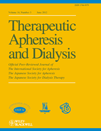Morning Hypertension Determined by Self-Measurement at Home Predicts Left Ventricular Hypertrophy in Patients Undergoing Continuous Ambulatory Peritoneal Dialysis
Abstract
This study aimed to clarify the relationship between blood pressure (BP, mm Hg) measured by patients in the morning at home and left ventricular hypertrophy (LVH), which is a strong predictor for morbidity and mortality due to cardiovascular disease in patients undergoing continuous ambulatory peritoneal dialysis (CAPD). We recorded self-measured morning BPs and BPs measured at hospital check-ups (hospital BPs) in 33 patients undergoing CAPD (mean age, 64.0 years) and compared them with left ventricular mass (LVM) derived from echocardiographic examinations. The mean morning BP was 137/75, the mean hospital BP was 140/80, and the mean LVM (g/m2.7: corrected by height) was 61.8. Of the subjects, 72.7% had LVH (LVM > 51). The morning BP (systolic) was positively correlated with LVM (P = 0.0022, R = 0.508), and the hospital BP (systolic) was weakly correlated (P = 0.0534, R = 0.339). The adjusted odds ratio for LVH was significantly higher in patients with a morning BP (systolic) ≥ 135 (15.9; 95% CI, 1.3 to 198.5) than in patients with a morning BP (systolic) < 135. In conclusion, morning hypertension determined with self-measured BP was positively correlated with LVH, therefore self BP monitoring could be a useful method to predict LVH in CAPD patients.




